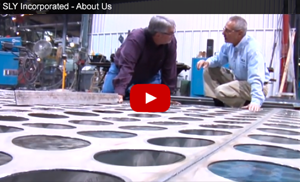 Fly ash, a byproduct of coal combustion poses unique challenges in dust collection. Effective systems are essential to manage particulate loading, fly ash characteristic, higher design temperatures all while meeting emissions standards. Sly specializes in custom-designed solutions that optimize recovery and ensure safety, making us a trusted partner in the industry.
Fly ash, a byproduct of coal combustion poses unique challenges in dust collection. Effective systems are essential to manage particulate loading, fly ash characteristic, higher design temperatures all while meeting emissions standards. Sly specializes in custom-designed solutions that optimize recovery and ensure safety, making us a trusted partner in the industry.
Understanding Fly Ash Dust Characteristics
Dust load is a primary concern, as fly ash can produce high volumes of fine particles depending on the combustion process. Fly ash typically consists of particles smaller than 100 microns, with highly distinctive material and flow characteristics. It is a fine, glass-like powder rich in silicon dioxide and aluminum oxide, making it highly abrasive. It often contains trace amounts of toxic metals, requiring careful handling. The dust can fluidize during transfer, complicating collection efforts. In addition, temperature control is essential when dealing with fly ash, which can be extremely hot post-combustion. Cooling the air before it enters the dust collector helps protect equipment and maintain optimal performance. Effective dust collection design must account for these characteristics to ensure efficient capture and minimize wear on equipment.
Key Considerations in Dust Collection Design
Designing a baghouse to capture fly ash effectively involves several key considerations beyond just dust loading. Each factor plays a vital role in achieving optimal system performance, efficiency, and longevity. Below are some key factors:
1. Filter Media Selection and Performance:
The characteristics of fly ash, including particle size, abrasiveness, and temperature, influence the choice of filter media. Fly ash’s fine and often abrasive nature requires filter materials that can withstand these conditions without frequent replacement or damage. Proper filter media selection ensures efficient filtration, reducing the risk of premature wear.
2. System Sizing and Air-to-Cloth Ratio:
The volume of air to be filtered and the density of fly ash impact the air-to-cloth ratio. A system sized to handle the air volume and dust characteristics ensures that the baghouse operates within its ideal air-to-cloth range, optimizing filter life and preventing overload. Correct sizing also reduces pressure drop and minimizes operational disruptions.
3. Cleaning Mechanism Efficiency:
Baghouses use mechanisms like pulse jets or shakers to clear dust from the filters. Fly ash, with its potential for fine buildup, requires a cleaning system powerful enough to dislodge particles effectively. This avoids filter clogging and maintains efficiency. Designing with fly ash in mind ensures that the cleaning mechanism can keep up with the application’s demands without excessive downtime.
4. Temperature and Moisture Control:
Fly ash is often produced in high-temperature environments, so the baghouse must be designed to withstand these conditions. Temperature-resistant materials and insulated ducts may be necessary. Moisture control is also critical, as moisture can cause fly ash to clump, increasing the risk of clogging.
5. Dust Handling and Hopper Design:
The collected fly ash must be managed efficiently to prevent buildup and blockages. Hopper and discharge systems must be sized and configured to accommodate the fly ash volume, avoiding interruptions in airflow and ensuring a steady collection process. Proper hopper design also prevents dust re-entrainment and minimizes potential emissions.
6. Maintenance Frequency and Costs:
The abrasive nature and fine particle size of fly ash may lead to more frequent maintenance. Designing the baghouse to accommodate these characteristics helps extend component life, reduces filter replacement frequency, and minimizes labor costs. Access to filters and components is essential for straightforward maintenance and longer system life.
7. Regulatory Compliance:
Fly ash can contain hazardous elements, making emissions control crucial. Designing the baghouse to capture fine particulates and prevent leaks ensures compliance with regulatory standards. This not only prevents fines and penalties but also upholds air quality standards and corporate responsibility.
Benefits of Custom-Designed Systems
Custom-designed dust collection systems offer numerous advantages for managing fly ash. Tailored solutions ensure that all aspects of your specific operation are considered, from dust load to airflow and temperature requirements. Sly offers a range of equipment suited for fly ash applications:
- TubeJet® Pulse Jet Collectors: These efficient dust collectors enable minimal downtime and optimal performance in high-dust environments.
- Cartridge Dust Collectors: These collectors are ideal for managing dry, free-flowing fly ash dust, offering easy maintenance and energy efficiency.
- Reverse Air Collectors: These energy-efficient systems use low-pressure air for effective filter bag cleaning and reduced operating costs.
By customizing these systems to fit your needs, you can achieve optimal performance, reduce maintenance, and ensure safety and environmental standards compliance.
Sly's Expertise in Fly Ash Dust Collection
With over 150 years of experience, Sly Inc. excels in designing custom dust collection systems for fly ash. Our expertise ensures efficient, durable solutions tailored to your needs. Contact us today to discuss your requirements and request a quote for a custom-designed system that optimizes performance and safety.
Tags: industrial dust collector, industrial applications, Fly Ash





